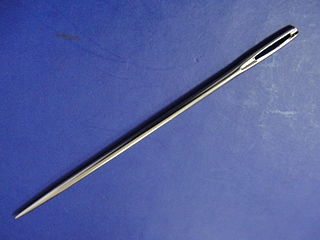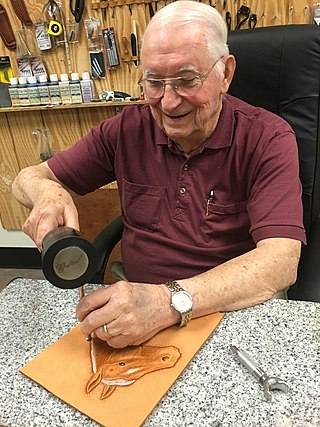
Saddle stitch is a hand-sewing stitch commonly used in bookbinding, saddle and bridle making, leathercraft, and shoemaking.

Saddle stitch is a hand-sewing stitch commonly used in bookbinding, saddle and bridle making, leathercraft, and shoemaking.
Saddle stitch uses two threads in alternating running stitches through a single line of holes. The holes may be created by the sewing needles themselves in lighter materials, or by an awl, [1] pricking iron, [2] or stitching iron [3] in thicker materials, such as leather.
Compared to the more common lockstitch often sewn by machine, breaking one side of a saddle stitch loosens only one side of the stitch, rather than several surrounding stitches on both sides. [4]
One variant of the saddle stitch, with threads running parallel, rather than twisting, is designated stitch number 201 by ISO 4915:1991. [5]

A sewing machine is a machine used to sew fabric and materials together with thread. Sewing machines were invented during the first Industrial Revolution to decrease the amount of manual sewing work performed in clothing companies. Since the invention of the first sewing machine, generally considered to have been the work of Englishman Thomas Saint in 1790, the sewing machine has greatly improved the efficiency and productivity of the clothing industry.

Appliqué is ornamental needlework in which pieces or patches of fabric in different shapes and patterns are sewn or stuck onto a larger piece to form a picture or pattern. It is commonly used as decoration, especially on garments. The technique is accomplished either by hand stitching or machine. Appliqué is commonly practised with textiles, but the term may be applied to similar techniques used on different materials. In the context of ceramics, for example, an appliqué is a separate piece of clay added to the primary work, generally for the purpose of decoration.

Chain stitch is a sewing and embroidery technique in which a series of looped stitches form a chain-like pattern. Chain stitch is an ancient craft – examples of surviving Chinese chain stitch embroidery worked in silk thread have been dated to the Warring States period. Handmade chain stitch embroidery does not require that the needle pass through more than one layer of fabric. For this reason the stitch is an effective surface embellishment near seams on finished fabric. Because chain stitches can form flowing, curved lines, they are used in many surface embroidery styles that mimic "drawing" in thread.

A hem in sewing is a garment finishing method, where the edge of a piece of cloth is folded and sewn to prevent unravelling of the fabric and to adjust the length of the piece in garments, such as at the end of the sleeve or the bottom of the garment.

In everyday language, a stitch in the context of embroidery or hand-sewing is defined as the movement of the embroidery needle from the back of the fibre to the front side and back to the back side. The thread stroke on the front side produced by this is also called stitch. In the context of embroidery, an embroidery stitch means one or more stitches that are always executed in the same way, forming a figure. Embroidery stitches are also called stitches for short.

A sewing needle, used for hand-sewing, is a long slender tool with a pointed tip at one end and a hole to hold the sewing thread. The earliest needles were made of bone or wood; modern needles are manufactured from high carbon steel wire and are nickel- or 18K gold-plated for corrosion resistance. High-quality embroidery needles are plated with two-thirds platinum and one-third titanium alloy. Traditionally, needles have been kept in needle books or needlecases which have become objects of adornment. Sewing needles may also be kept in an étui, a small box that held needles and other items such as scissors, pencils and tweezers.

Backstitch or back stitch and its variants stem stitch, outline stitch and split stitch are a class of embroidery and sewing stitches in which individual stitches are made backward to the general direction of sewing. In embroidery, these stitches form lines and are most often used to outline shapes and to add fine detail to an embroidered picture. It is also used to embroider lettering. In hand sewing, it is a utility stitch which strongly and permanently attaches two pieces of fabric. The small stitches done back-and-forth makes the back stitch the strongest stitch among the basic stitches. Hence it can be used to sew strong seams by hand, without a sewing machine.

A stitching awl is a tool with which holes can be punctured in a variety of materials, or existing holes can be enlarged. It is also used for sewing heavy materials, such as leather or canvas. It is a thin, tapered metal shaft, coming to a sharp point, either straight or slightly bent. These shafts are often in the form of interchangeable needles. They usually have an eye piercing at the pointed end to aid in drawing thread through holes for the purpose of manual lockstitch sewing, in which case it is also called a sewing awl. Stitching awls are frequently used by shoe repairers and other leatherworkers. Sewing awls are used to make lock stitches. The needle, with the thread in the eye is pushed through the material. The thread is then pulled through the eye to extend it. As the needle is pushed through the material, the extra thread from the first stitch is then threaded through the loops of successive stitches creating a lock stitch. The action is likened to that of a "miniature sewing machine". Styles may vary, as they are adapted to specific trades, such as making shoes or saddles. They are also used in the printing trades to aid in setting movable type and in bookbinding.

Al Stohlman was an American pioneer in leathercraft and continues to influence hundreds of thousands of leathercrafters worldwide. He and his wife Ann produced hundreds of magazine articles, doodle pages and other resources still used in the leathercraft industry. A museum featuring much of their life's work is part of a collection of leather art located in the lobby of the Tandy Leather Factory Headquarters in Fort Worth, Texas.

A selvage or selvedge is a "self-finished" edge of a piece of fabric which keeps it from unraveling and fraying. The term "self-finished" means that the edge does not require additional finishing work, such as hem or bias tape, to prevent fraying.

The straight or running stitch is the basic stitch in hand-sewing and embroidery, on which all other forms of sewing are based. The stitch is worked by passing the needle in and out of the fabric at a regular distance. All other stitches are created by varying the straight stitch in length, spacing, and direction.

In the textile arts, a stitch is a single turn or loop of thread, or yarn. Stitches are the fundamental elements of sewing, knitting, embroidery, crochet, and needle lace-making, whether by hand or machine. A variety of stitches, each with one or more names, are used for specific purposes.
Sewing is the craft of fastening or attaching objects using stitches made with needle and thread. Sewing is one of the oldest of the textile arts, arising in the Paleolithic Era. Although usually associated with clothing and household linens, sewing is used in a variety of crafts and industries, including shoemaking, upholstery, sailmaking, bookbinding and the manufacturing of some kinds of sporting goods. Sewing is the fundamental process underlying a variety of textile arts and crafts, including embroidery, tapestry, quilting, appliqué and patchwork.
Buckstitching is a technique used in leathercraft for securely joining two or more pieces of heavy leather along a seam. It is a simple, durable technique. Buckstitching is performed using a pronged metal tool that leatherworkers call a "buckstitch chisel" that has between one and five cutting tips. The chisel is held over the leather pieces to be joined, and is then struck with a mallet until the chisel penetrates all of the leather and produces what are called lacing slits. This is repeated along the entire seam. Next, a special leatherworker's needle is used to thread a wide sturdy lace back and forth through all of the slits.

Tandy Leather Factory, Inc. is an American specialty retailer and wholesale distributor of leather and leatherwork related products. It operates more than 100 stores worldwide. Originally part of the Tandy Corporation, Tandy Leather has gone through a series of acquisitions and mergers, eventually being sold to The Leather Factory in 2000. The Tandy Leather flagship store next to their corporate headquarters in Fort Worth, Texas also houses the Al and Ann Stohlman Leathercraft Museum.

The Al Stohlman Award for Achievement in Leathercraft honors the accomplishments of individual leather workers worldwide for their continued dedication and exemplary service to leathercraft. The criteria for nominations are someone who has demonstrated continued devotion to the advancement of leathercraft, following the example of Al Stohlman, who is most well-known for publishing over 40 books, creating numerous pattern packs, and innovating many new tools for leatherworking.

George Hurst was an American leather artist known for his contributions to leathercraft instruction. With nearly 8 million views on his leatherworking tutorial videos on YouTube, Hurst is recognized internationally as a teacher. His contributions to the leather industry over the last 50 years have been recognized with an Al Stohlman Award for Achievement in Leathercraft, the Lifetime Achievement Award by the International Federation of Leather Guilds, and the Master Leather Artisan Award by the Academy of Western Artists.

A coverstitch is formed by two or more needles which add straight stitches to one side of the fabric and a looper thread on the opposite side of the fabric that zig-zags between the straight stitches. A coverstitch results in parallel lines of straight stitches on one side of the fabric and an overcast stitch on the reverse side. It is widely used in garment construction, particularly for attaching trims and flat seaming where the raw edges can be finished in the same operation as forming the seam.
In leathercraft, a pricking iron is a handheld tool resembling a fork which is used to create dimples in leather a fixed distance apart that can then be pierced with a awl and stitched. A pricking iron is different from a leather chisel in that a chisel is designed to pierce the holes, not just mark their position, and does not require follow-up with an awl.